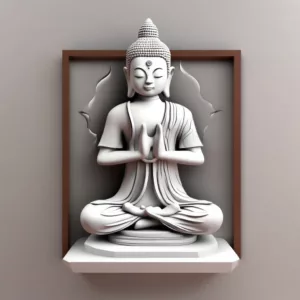14 Benefits and a Self-guided Method
Morning meditation can be life-changing. Here are 14 benefits of morning meditation and a self-guided meditation structure to make your day truly awesome.
Table of Contents
Morning Meditation Benefits

Meditation in the morning benefits creates an optimal possibility for the day. The research paper linked shows that even beginners experience increases in mood, memory, and cognitive function. Meditation enables you to do many positive things:
- Control your state of mind
- Guide and direct it where you want and how you want.
- Set a tone for your day based on meditation.
- Change from a negative outlook to a positive outlook.
- Choose to work with a more patient attitude
- Set a program to release anxiety and stress throughout the day.
- Generate a sense of calmness.
- Cultivate strength.
- Elevate wakefulness.
- Center the mind in one’s being.
- Awareness can expand.
- Elevate your sense of joy and life.
- Be more productive.
- Increase your self-esteem.
Best Morning Meditation
The best morning meditation is the one that you need on that day and at that point in your life. Typically, it would be a well-focused meditation on the breath or some form of light or some form of positive entity such as the Buddha or Jesus or whatever. Generally, you’d want to establish the motivation for what you want to accomplish and then determine what you should be doing.
I typically recommend doing meditations for multiple sessions, and for a length of time, like a few months. Rather than changing meditations every day, it’s more difficult to get into them if you change it every day.
If you’re feeling depressed, raise your gaze and bring up some energy. Meditate a bit more on light. If you’re feeling anxious, you can see this for an anxiety meditation. Walking meditation can also be a good morning meditation. If you feel sluggish, then get outside, get some light, get some air. That can be very helpful.
In the morning, it’s best to concentrate on developing clarity, not on a complex meditation, an overly involved one or too long of one particularly, unless you have a lot of time and you like that. Instead, choose a method that sets the tone of engaging in life in a good manner with virtue. Generally, just set a good motivation such as the bodhisattva motivation or even the refuge.
Generate the motivation to cause no harm or the motivation to make a positive impact on the world. Then do a simple meditation of following the breath to settle and clarify the mind.
How to meditate like a yogi
and enter profound samadhi
Short morning meditation
A short morning meditation would be: assume a good posture with a strong back, legs crossed, and focus your eyes on the floor six to eight feet in front of you. Exhale stale air if you know how to do that.
Technique: close your right nostril with the right index finger and breathe out through the left fully, then back in. Repeat by closing the left nostril and breathing out through the right then back in. Finally, breathe out and back in through both nostrils. Meditate that you’re clearing out the heaviness of the night and any negative build-ups. Repeat the cycle 2 more times, if you wish.
Next, place your mind upon the object of meditation. Generally, the breathing works well. As the breathing goes in and out, allow it to release any concerns or worries. Regrets about the past, concerns about the future, getting caught up in what’s happening: just let it all go. Be present, release any negative energies, and keep the mind in the breath.
As the mind stays on the breathing, other thoughts will tend to fall away. This will create a powerful lift, a means to step into your day. At the end of the session, if you like, you can dedicate the merit for the benefit of all beings asking that your activities in meditation and in your life are helpful to the world. There are many dedications of merit. There’s one at the end of this post you can use.
Morning meditation for positive energy
Positive Energy Morning Meditation:
- Take a proper meditation posture
- Settle your eyes on the floor
- Follow the breathing
- Bring the mind to a settled state, then
- Raise the gaze and look straight outwards
- Send out goodness as light with the rhythm of the breathing
As you breathe out, send out good wishes and energy to all beings in the world. Really push out that positive energy and think of the negative energy that might come back towards you in a sending and taking way (tonglen). Allow yourself to accept any negative energy and to be unharmed by it.
You can remove it from the equation of the world so that it is no longer a problem for you or anyone else. Simply breathe it in and dissolve it into nothingness. Then as you breathe out, just let out pure light and goodness in the form of light. Continue for the duration of the session, then end by dedicating the merit.
The key of course during any meditation is to get the mind focused on the meditation.
Five-minute morning meditation.
To do a very quick meditation, the thing you need is to bring the mind into focus forcefully and quickly. If you’re only practicing for five minutes, it’s easy to waste the whole five minutes with nothing happening. Breathing meditations tend to be a little slower and they can be a bit deeper.
So if you’re just doing a quick meditation, meditate on a statue of the Buddha or on a lit candle and see your mind as the object of meditation. Your mind is the Buddha or your mind is just the flame of the candle gently, steadily, evenly burning up any kind of negativity that comes towards it and releasing it. Stabilize the mind as the object and ask that it remain that state all day. Meditate like that for five minutes and then dedicate the merit.
Morning meditation for anxiety.
Meditating for anxiety in the morning can help. A lot of people have anxiety when they first wake up and get up concerned about the world and so forth. Here is a longer post on defeating anxiety through meditation with a number of methods.
A simple meditative approach to this is twofold.
- Release the anxiety
- Develop strength
You need strength because there will always be more. Anxiety is a normal fact of life. Avoid an antagonistic relationship where you think you overcome anxiety once and for all, where it never bothers you again, where it never occurs again. This will just reinforce it.
Instead, release it, and as much as it stays is fine, and whatever goes, goes. Give it time to gently dissipate and give it plenty of space. Just open it up, let it take as much space as it needs. You’ll find that it can only fill so much space, but you have the entire universe. Anxiety is only so much energy, it’s finite, whereas the universe is infinite.
So, take a seat, gaze softly at the floor in front of you, then try and settle the mind onto the breathing. This may be difficult if you’re feeling anxiety. If so, meditate directly on the anxiety and open up as much space as it requires.
Make sure your posture remains good and strong and your gaze is steadily relaxed in front of you. As you give it space, gently turn your mind towards your own self-existing strength, the strength that abides in the heart. Look into your heart and know with confidence that you have a bottomless supply of strength. You can relate to whatever is happening. You can handle any anxiety that comes up, any concerns.
Meditate on that strength – you can ask the universe or your favorite figure to bless you with strength to handle any challenges that arise in the mind and to see through the seeming solidity of anxiety. Here’s a whole course on meditation for anxiety. It’s a video course. I hope it helps.
At the end, dedicate the merit if you wish. See the end of this post. This can seal the meditation so that it continues to help.
morning meditation for beginners
Sit down in a good posture. Focus the mind on the breathing. It can be the in and out breath, if you like. Let the mind settle. The beginning of meditation are about training the mind to meditate properly, to meditate well. You are learning to meditate properly. This is difficult in the beginning, so make a relationship with the fact that it won’t be easy and it may take time to understand meditation.
In the beginning, if you’re unsure if you really want to meditate, it’s good to make a commitment to meditating for one to three months – every morning for 10 minutes or 20 minutes. Whatever amount of time makes sense to you. Most important is that you maintain a commitment to going in and meditating.
If you find that you’ve committed to too long of a session, that you just can’t handle it, dial back the time rather than stopping altogether. Go from 20 minutes to 10 minutes, or 10 minutes to 5 minutes. But fulfill the commitment by going in every day. This fulfillment will have positive effects in your life, as well. Not giving up is a virtue. It develops strength.
The main thing is to take the proper posture, look at the ground in front of you with a soft gaze, and place the concentration, the focus of the mind on the breathing, on the breath, whatever that means to you. Just follow the breath, and when thoughts arise, just barely glance at them and release them. They may continue a bit longer but do not fixate on the thoughts. Bring the mind back to the object of meditation. When it becomes stable, then you’re truly meditating. See How to Meditate Correctly for a detailed meditation instructions.



Self-guided morning meditation script
- Good Posture
- Refresh Motivation
- Clarify the Method
Sit down in proper posture, establish your motivation, and establish the process of meditation in your mind.
Say, “I’m now going to meditate for X number of minutes. I want to meditate in order to become more patient, in order to have a good day, in order to not be angry, in order to be beneficial, be a benefit to the world, in order to be successful.” Whatever it is, say it out loud, or if somebody’s sitting right there, just say it in your mind.
Next say what you’re doing in that meditation, the actual process. For example, “meditation is placing the mind on the object and leaving it there.” This is the simplest, most direct definition of meditation that you could probably find. It’s the essence of meditation. Other things build upon that and build around it, but without that, it cannot properly, called meditation.
So you might say, “I’ll now place my mind on the object, on the breathing process, on the breath. If it wanders, I will gently bring it back as many times as necessary.” If you like, place your hands in Anjali and say the following chant,
“May I develop the virtue of <whatever you want – Patience, for example> in this meditation. May I receive the love and blessings of the universe and <Wisdom being like buddha or Jesus> so that I can develop this virtue. May this virtue benefit the world.”
Now settle the mind into the meditation and focus on the object, the breathing. Finally, dedicate the merit. You can use the dedication at the end of this post.

May all beings be happy
May all beings be peaceful
May all beings be safe
May all beings awaken to the light of their true nature
May all beings be free

May all beings be happy
May all beings be peaceful
May all beings be safe
May all beings awaken to the light of their true nature
May all beings be free







